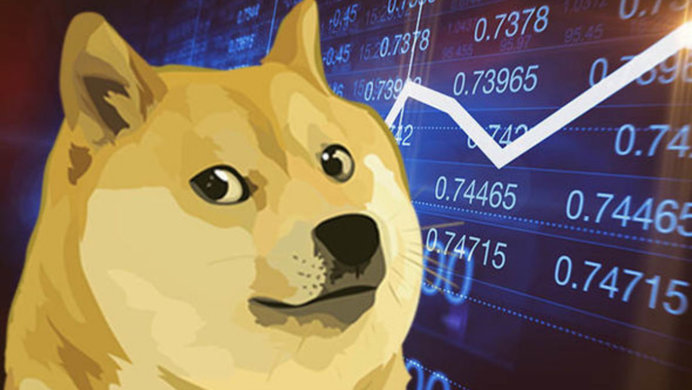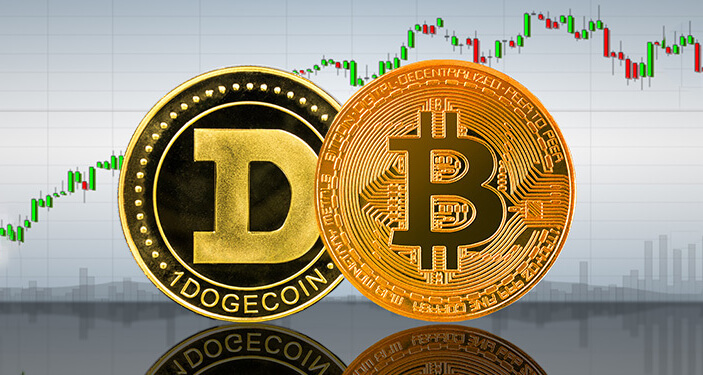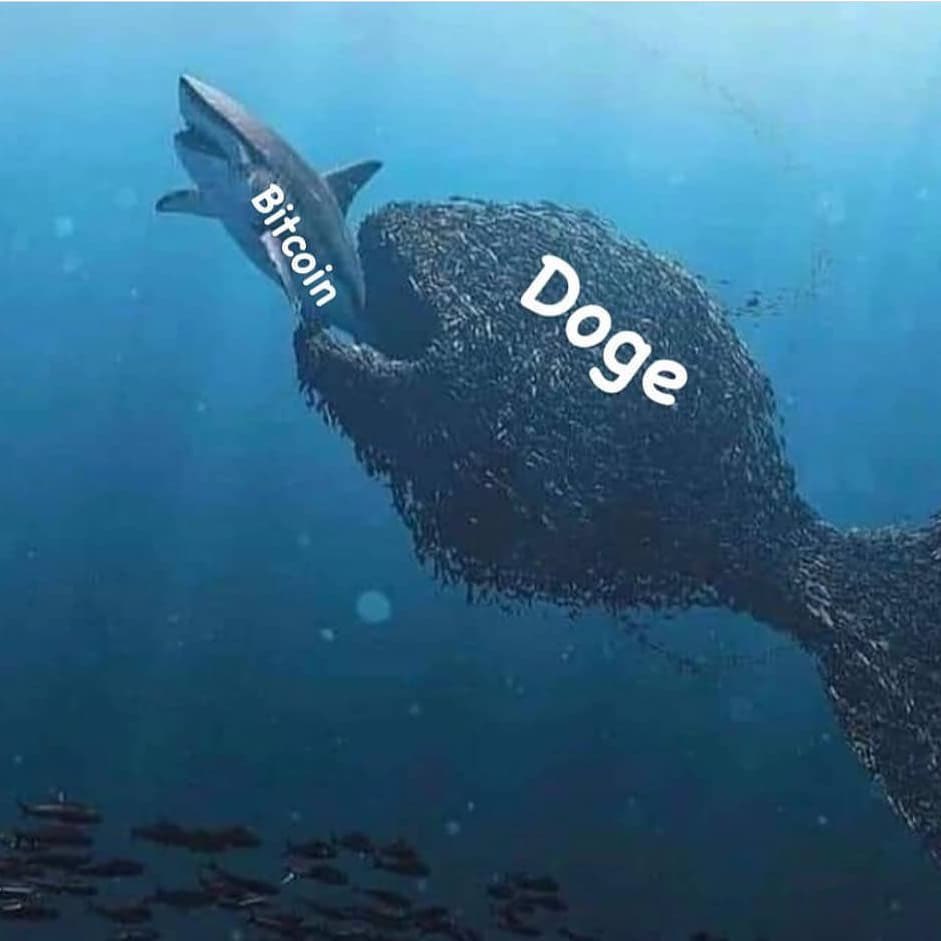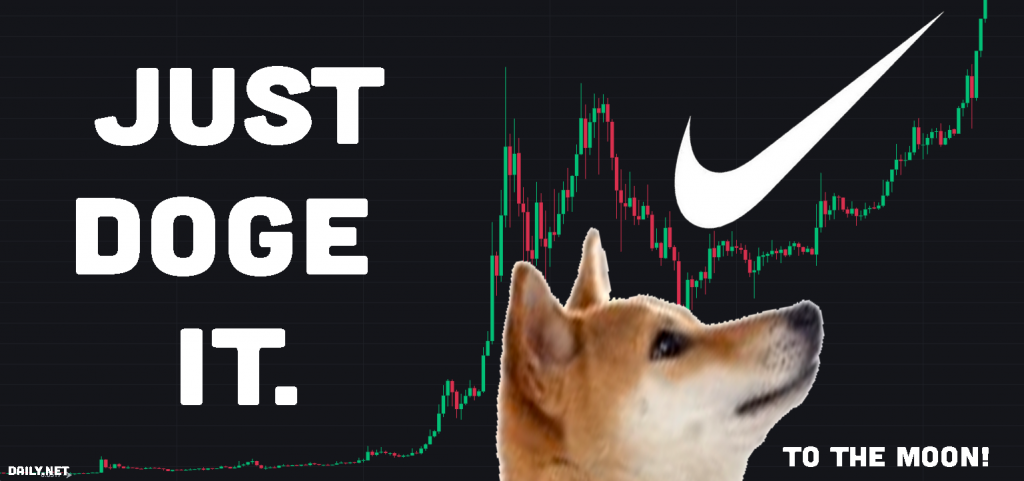
You’ve seen Dogecoin and its Shiba Inu plastered all over the place in 2021 (Super Bowl, Doge Day, SNL) and thus far have resisted the temptation of jumping aboard the rocket ship “to the moon”. You’re curious, interested, even anxious to get in on the crypto action- but hesitant: is Doge a joke? Is it a scam? Is it a “pump and dump” scheme that will leave you bankrupt?
The truth is complicated, but we’ll cut through all the crap and explain exactly why Dogecoin has a bright future, despite but some “crypto experts” claim.
Bitcoin and Doge are similar
Whether Bitcoin early-adopters want to admit it or not, Bitcoin (BTC) and Dogecoin (DOGE) are incredibly alike. They’re both cryptocurrencies built on blockchain technology and have absolutely $0 of intrinsic value.
Since 2009, Bitcoin supporters have faced vicious criticism claiming that their “digital money” is “fake” and “bullshit”. In 2013, most people thought Bitcoin was a ponzi scheme. During its meteoric rise in 2017 it was still called a ponzi scheme. And guess what? In 2021 at $50k it’s still called a ponzi scheme.
Elon Musk, the Dogefather himself, hated on Bitcoin as recently as December 2020:
Bitcoin is almost as bs as fiat money
— Elon Musk (@elonmusk) December 20, 2020
The people agreeing with Musk were the traditional types, like economist Peter Schiff, who still prefers stocks and bonds to crypto despite their outrageous ascent in value.
Actually its more BS. Its digital fiat that is not legal tender, is not acceptable by any sovereign for tax payments, has no tradition of use as either a medium of exchange or unit of account, and is not used in financial contracts — loans, insurance, rents, employment, etc.
— Peter Schiff (@PeterSchiff) December 20, 2020
It seems there are only 3 types of people in the world:
- People who are happy they bought Bitcoin
- People who wish they bought Bitcoin
- People who are waiting for the whole thing to blow up
It started at pennies and grew to dollars. Supporters continually bought and sold at escalating prices into the hundreds. As FOMO built, more and more people joined the ranks, creating momentum that sparked a parabolic rise. Haters constantly claimed Bitcoin would crash, it often did, but each time it set higher lows.
Detractors eventually became curious, dipped their toes in the water, enjoyed success, and soon became supporters. Case and point: one month after denouncing bitcoin, Elon Musk changed his Twitter profile to “#bitcoin” and soon after made this announcement:
You can now buy a Tesla with Bitcoin
— Elon Musk (@elonmusk) March 24, 2021
Yet the instrinsic value of Bitcoin is still $0. The only reason Bitcoin is worth $50k+ is because it has a community of people that believe it should be worth $50k+ dollars. This is the same for Dogecoin: intrinsically it is worth $0 but the market sets the value. It gets called a ponzi scheme and people claim it will crash to zero, but each time it sets higher lows.
At $50k bucks, Bitcoin now seems expensive and boring to regular people. Those who missed out are wondering how they can get in on the next big thing. They hear about the adorable and hilarious DOGE (which stands for “Do Only Good Everyday”), it costs less than $1, keeps going up in value, and has a friendly community supporting it. The code itself is nearly identical to Bitcoin, it just has a different name, fun mascot, and some minor differences. It seems like the perfect introduction to Crypto. And it is.
For those that HODL Dogecoin (buying with no plans to sell, intentional typo of “Hold”) Dogecoin has been the perfect Crypto Starter Kit. Buy only what you can afford to lose, watch the market over days and weeks, learn the ropes of crypto, and make trades when you feel ready. As Mark Cuban says, Dogecoin is a whole lot better than a lottery ticket: you might make a bunch of money, but at the very least, you’ll have fun learning about crypto and blockchain.
After jumping an astonishing 12,000% in the first few months of 2021, Dogecoin has turned heads around the world. Now that coin has a track record of success (albeit limited) and exponential growth, we’ve got 3 types of people on earth:
- People who are happy they bought Dogecoin
- People who wish they bought Dogecoin
- People who are waiting for the whole thing to blow up
Sound familiar?
The “crypto experts” angrily denouncing Dogecoin sound like grumpy old men shouting “get off my lawn” from the front porch of a house they bought with Bitcoin profits. They have become their own fathers, shouting at their younger selves, blinded by Bitcoin the same way boomers’ short-sightedness kept them locked into stocks and bonds.
Dogecoin lovers playfully shouting “to the moon” irks the last nerve of Bitcoin enthusiasts, who can’t seem to understand that DOGE and BTC are both Z1 equine, just horses of a different breed and color.
Bitcoin supporters should change their tune: Dogecoin is bringing an entirely new demographic into the crypto space, training them up, and increasing the amount of money in crypto as a whole. Dogecoin, not Bitcoin, is earning crypto the most exposure to new types of people: what’s not to like? Bitcoin is “The Bank that Crypto Built” but Dogecoin is the catalyst filling stadiums with sell out crowds.
Is Bitcoin better than Dogecoin?

The primary reason that Bitcoin is more valuable than Doge is that it had first mover advantage, built a huge market cap, and gained institutional support. Deservingly so: we have Bitcoin to thank for the entire industry existing.
This head start has meant that more people are invested in Bitcoin than any other cryptocurrency, both financially and from a resource and development standpoint. It’s an absolute gigantic movement, not owned or controlled by any private entity, and worth over $1 trillion dollars.
Building a competitive advantage based on power in numbers is called the “network effect”. It’s the reason tech companies like Facebook are so hard to compete with- everyone uses Facebook because everyone is on Facebook. But remember MySpace? How about Instagram, Snapchat, and TikTok? Momentum can shift, even when it seems impossible due to an insurmountable lead.
It’s foolish to think that Bitcoin is better than Dogecoin. It isn’t. It’s just different. People prefer different things. Ford or Tesla? Nike or Adidas? Baseball cards or Beanie Babies? 90s rap or mumble rap? Minecraft or Roblox? ZED Racing or NFT Art? Bitcoin or Dogecoin? Xbox or Playstation? How about Nintendo? Different strokes for different folks. Emerging markets and opportunities are often decided by an empowered youth, and that’s exactly who has latched onto Doge, whether or not it’s your personal cup of tea.
Arguments calling Dogecoin a pyramid scheme, ponzi scheme, and a “pump and dump” should remember that Bitcoin faces the same exact criticism for the same exact reason. It outgrew that criticism just as Doge has outgrown the joke it was founded upon. The main difference between DOGE and BTC is that Bitcoin was first, but consider it the last and only at your own peril.
The harsh reality is that yes, Dogecoin could drop to $0… but guess what? So could Bitcoin. Neither of them have any intrinsic value, a fact that few are willing to admit. Rather than viewing the success of Bitcoin as an obstacle of Dogecoin, the inverse makes sense: Bitcoin is a case study in how and why Dogecoin can be successful, despite their challenges and flaws.
Infinite Supply = Worthless?
The biggest detractors of Dogecoin claim there is an infinite supply of coins, rending them worthless for anyone who does their own research. That’s simply not true: the supply of Dogecoin is not infinite.
- There are currently 136 Billion Dogecoin
- 10,000 Dogecoin are created every minute (by mining)
- 10,000 Dogecoin per minute = 600k per hour
- 600k Dogecoin per hour = 14.4M per day
- 14.4M Dogecoin per day = 5.256B per year
Does creating 5,256,000,000 new coins each year sound ridiculous? Let’s put it in perspective.
With exactly 5.256 billion new Dogecoin created each year, and a current supply of 136 billion Dogecoin, the current inflation rate of Doge is about 4%. As the total volume of Dogecoin increases, the inflation rate decreases, because the fixed number of new coins each year is a smaller proportion of total coins. Technically Dogecoin does have infinite supply, but only over an infinite amount of time, which grossly misrepresents “infinite”.
Dogecoin Inflation Rate (Estimated)
| Year | Doge Created | Total Doge | Inflation Rate |
| 2021 | 5.256 Billion | 136.4 Billion | 3.85% |
| 2022 | 5.256 Billion | 141.6 Billion | 3.71% |
| 2023 | 5.256 Billion | 146.9 Billion | 3.58% |
| 2024 | 5.256 Billion | 152.1Billion | 3.45% |
| 2025 | 5.256 Billion | 157.4 Billion | 3.34% |
| 2026 | 5.256 Billion | 162.6 Billion | 3.23% |
| 2027 | 5.256 Billion | 167.9 Billion | 3.13% |
| 2028 | 5.256 Billion | 173.1 Billion | 3.03% |
| 2029 | 5.256 Billion | 178.4 Billion | 2.95% |
| 2030 | 5.256 Billion | 183.7 Billion | 2.86% |
The United States Dollar has an average annual inflation rate of 3.04% since 1929, not far from the inflation rate of Dogecoin today. Considering Dogecoin’s high growth rate and combined with the likelihood of lost coins over time, the “problem” of Dogecoin as an inflationary asset is essentially non-existent. Not to mention, unlike USD and other fiat, the inflation rate is not only predictable, it’s pre-determined.
Bitcoin, on the other hand, has a fixed number of coins at 21 million, making it a deflationary asset. That means that all things being equal, BTC should grow in value over time. However, that growth comes at a cost: high transaction fees and high coin prices. The inflationary vs. deflationary nature of DOGE vs. BTC is a key difference between the two, but it doesn’t make one better or worse, it simply makes the economics of each token slightly different (tokenomics).
5 Whales own 80% of DOGE

Another common misconception is that DOGE is heavily manipulated by a small number of investors that own the vast majority of Dogecoins. They move the market up with huge buys, trick the market into following the momentum, and then sell a massive quantity of their coins to take profits, tanking the price in the process.
These huge investors that can buy and sell millions of coins at the snap of their finger are called “whales”. They’re not unique to Dogecoin: all cryptos have huge investors that move the market.
Cryptocurrency is held in something called a “wallet” which is a digital version of the leather thing that old-timers keep in their back pocket. However, not everyone who owns cryptocurrency has a wallet: exchanges like Robinhood and Binance allow you to buy and sell crypto without actually owning the crypto itself. The exchange can hold the crypto for you, in their wallet, until you decide to sell it or transfer it elsewhere. That’s called a coin custodian (they have custody of your coin).
If you look at the Top 100 Dogecoin wallets, you’ll see that one wallet owns 28% of all Dogecoins. Critics claim that if this one whale were to sell their position, they could instantly crash the price of Dogecoin to near zero. But here’s the thing: that wallet is likely held by Robinhood and its wealth spread across tens of thousands of customers who make their own buying and selling decisions. There are 10 other wallet addresses that own 1% or more of the total Dogecoin supply, but these too are likely exchanges.
It’s true that whales can manipulate markets, but as Dogecoin’s market cap increases and it’s value spreads across more independent wallets, the impact of any one buyer or seller diminishes. Bitcoin has a clear advantage in this regard.
Dogecoin vs Bitcoin: Minnows and Whales
| Wallet Value | # Dogecoin Wallets | # Bitcoin Wallets |
| $1+ | 3,014,968 | 33,675,866 |
| $100+ | 1,445,480 | 16,073,702 |
| $1k+ | 588,867 | 6,915,975 |
| $10k+ | 159,704 | 2,330,474 |
| $100k+ | 24,406 | 490,726 |
| $1 Million | 2,712 | 102,660 |
| $10 Million | 458 | 9,724 |
As you can see, Bitcoin has a ton more wallet diversity than Dogecoin. However, Bitcoin also has 21 times more “whales” with $10+ million in their wallets, a figure that’s proportionally larger than Dogecoin (based on market cap).
DOGE is now the #4 crypto coin ($75B+), trailing only BTC ($1 Trillion), ETC ($390 Billion), and BNB ($100B Billion). When whales sell and smaller investors gobble up the coins, it consolidates the wealth amongst new holders that don’t plan to immediately sell. As Dogecoin grows, like Bitcoin, it will have the opportunity to increase stability and decrease volatility by spreading its wealth across more wallets and more HODLers.
The bottom line is that the “whales” holding Dogecoin hostage aren’t all actually whales. As Dogecoin developer Patrick Lodder put it, they’re “a few “Fort Knox”es” holding coins for other people. The same is true for Bitcoin.
Dogecoin has no Developers

Another top complaint about Doge is that the development team is nearly non-existent and updates to the code are few and far between. But here’s the thing: since 2014, Dogecoin’s code has been based on Bitcoin core and its top developers are also contributors to the Bitcoin repository. Doge is literally just a version of Bitcoin.
Think to yourself: if the existing code “just works” is there a need for a huge development team? If Doge has reached $75 Billion in value with very little development, can you imagine the potential if Doge is able to attract more top talent?
Dogecoin has seen modest development updates since 2017 but the recent excitement behind the coin has sparked the first updates since 2019. Doge may have started as a joke but a valuation of $75 Billion is no laughing matter, unless you’re a HODLER laughing all the way to the bank.
If you’re criticizing Dogecoin because it’s using outdated technology, realize that the same exact comment applies to Bitcoin as well. Some former Bitcoin enthusiasts even call it the MySpace of crypto.
Side note: the claim that Dogecoin is easily subject to a 51% attack to cheat its network and print new coins is false “by several orders of magnitude”.
The Risk/Reward of Dogecoin

Let’s be clear: NOBODY should risk money that they can’t afford to lose. We’re definitely not suggesting you buy Dogecoin. Nobody knows if it will go up or down and even the “experts” are just making educated guesses. Dogecoin could go to $1, $2, $5 or all the the way to $0.07 or below. The same goes for Bitcoin, too: it could go to $100k, $1,000,000, or it could drop back down to $10k or below- nobody knows. It all depends on what the market collectively decides.
That being said, the challenges of Dogecoin also present opportunities. Whereas Bitcoin has somewhat matured, Dogecoin is just getting started. With each new regular Joe, celebrity, and company that endorses Doge, love for the coin has spreading, and catalysts are starting to develop.
Coinbase, one of the world’s largest crypto exchanges, still hasn’t listed Dogecoin for buying and selling. Sports teams like the Dallas Mavericks and Oakland A’s have started accepting Dogecoin for tickets and merch. What’s next? Elon Musk promised to put a literal Dogecoin on the literal moon, and although it was said on April Fool’s Day, fate loves irony.
Dogecoin is certainly more risky than Bitcoin but also has more immediate upside potential. It’s all about risk vs. reward and what you decide is worth it to you. You need to do your own research (DYOR), listen to different viewpoints and perspectives, and make the decision that’s best for you. Most people will want to start small and branch out as they learn more and find projects they enjoy and want to support.
Through this research, you’ll find many people denouncing Dogecoin, laughing at Dogecoin supporters, getting angry at Dogecoin HODLers, hurling insults, and making wild accusations. Just remember: Do Only Good Everyday. Not only is it possible for both Bitcoin and Dogecoin to successfully co-exist, the crypto space will be better for it.
One last thing that we can’t say it enough: never invest more than you can afford to lose! If you’re unsure how much you can afford, don’t invest at all. Consider nothing in this article financial advice, but rather entertainment, and do your own research!








